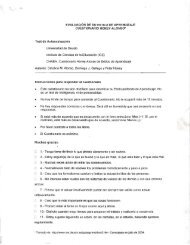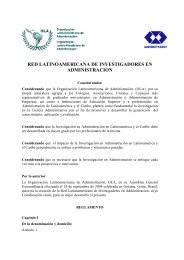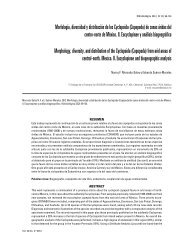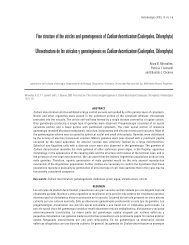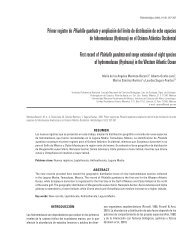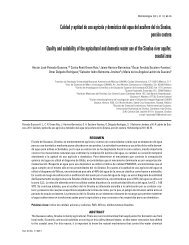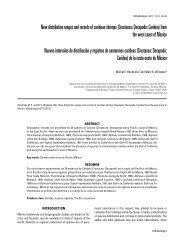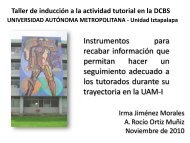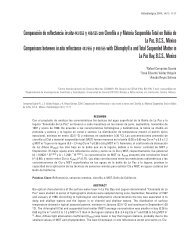Notes on some alpheid shrimps (Decapoda: Caridea) of Thalassia ...
Notes on some alpheid shrimps (Decapoda: Caridea) of Thalassia ...
Notes on some alpheid shrimps (Decapoda: Caridea) of Thalassia ...
Create successful ePaper yourself
Turn your PDF publications into a flip-book with our unique Google optimized e-Paper software.
226 Román-C<strong>on</strong>treras and Martínez-Mayén<br />
(Chace, 1972); South Lago<strong>on</strong> <strong>of</strong> Chengue, Tayr<strong>on</strong>a, Colombia (Alvarez-León,<br />
2003); Isla Cubagua, Venezuela (Hernández-Ávila et<br />
al., 2007).<br />
Ecological notes: In dead coral (Chace, 1972), am<strong>on</strong>g mangrove<br />
roots (Martínez-Iglesias et al., 1997), muddy-sand bottom<br />
with meadows <strong>of</strong> Halodule wrightii (Aschers<strong>on</strong>), Halophila baill<strong>on</strong>is<br />
Aschers<strong>on</strong> ex Dickie; also reported <strong>on</strong> meadows <strong>of</strong> T. testudinum<br />
(see Álvarez-León, 2003). Intertidal to 20 m (Martínez-Iglesias<br />
et al., 1996), sand substrate with <strong>Thalassia</strong>, depth around 0.5 m<br />
(present study).<br />
Local new records: Mahahual reef lago<strong>on</strong>, Quintana Roo.<br />
Synalpheus apioceros Coutière, 1909<br />
Synalpheus apioceros. Coutière, 1909: 27, fig. 9; Chace, 1972:<br />
86; Carvacho, 1979: 463; Felder & Chaney, 1979: 25; Rodríguez,<br />
1980: 155; Abele & Kim, 1986: 19, 226-227, figs. i-k; Christ<strong>of</strong>fersen,<br />
1998: 362; Markham et al., 1990: 421; Wicksten, 2005: 32.<br />
Synalpheus cf. apioceros. Almeida et al., 2007: 14.<br />
Material examined: Bahía del Espíritu Santo, <strong>on</strong>e specimen,<br />
May 2001.<br />
Distributi<strong>on</strong>: Southern Florida (Chace, 1972); Stets<strong>on</strong> and<br />
West Flower Garden Bank (Wicksten, 2005); Seven and One-half<br />
Fathom Reef, Texas (Felder & Chaney, 1979); Isla Cozumel and Cayo<br />
Culebras, Bahía de la Ascensión, Quintana Roo, Mexico (Chace,<br />
1972); the Antilles, from Anegada Island to Tobago (Chace,1972);<br />
to Santa Catarina, Brazil (Christ<strong>of</strong>fersen, 1998).<br />
Ecological notes: Rubble fields near sea grass beds and mangroves<br />
(Carvacho, 1979); eroded rocks, mollusk shells, cavities <strong>of</strong><br />
sp<strong>on</strong>ges and tubes <strong>of</strong> polychaetes in 10-12 m (Felder & Chaney,<br />
1979), sand and rocky substrate with T. testudinum, depth less<br />
than 1 m (present study).<br />
Local new record: Bahía del Espíritu Santo, Quintana Roo.<br />
Remarks: The morphology <strong>of</strong> the specimen examined agrees<br />
well with the descripti<strong>on</strong> and figures provided by Coutière (1909),<br />
and Abele & Kim´s (1986) key and illustrati<strong>on</strong>s to S. apioceros. Almeida<br />
et al. (2007) stated that S. apioceros is a species complex<br />
with at least two species in the western Atlantic.<br />
Synalpheus fritzmuelleri Coutière, 1909<br />
Synalpheus fritzmülleri. Coutière, 1909: 35-37, fig. 18.<br />
Synalpheus fritzmuelleri. Chace, 1972: 92; Christ<strong>of</strong>fersen,<br />
1979: 341; Felder & Chaney, 1979: 25; Markham & McDermott,<br />
1980: 1270; Williams, 1984: 102, fig. 70; Manning & Chace, 1990:<br />
22; Markham et al., 1990: 422; Hernández Aguilera et al., 1996: 36;<br />
Martínez-Iglesias et al., 1996: 35; Christ<strong>of</strong>fersen, 1998: 362; Mc-<br />
Clure, 2005: 175, fig. 38; Wicksten, 2005: 32; Hermoso-Salazar &<br />
Solís-Weiss, 2010 : 65-68.<br />
Synalpheus cf. fritzmuelleri. Almeida et al., 2007: 14.<br />
Material examined: Bahía de la Ascensión, <strong>on</strong>e specimen,<br />
January 2003.<br />
Distributi<strong>on</strong>: Bermuda (Markham & McDermott, 1980); <strong>of</strong>f<br />
Cape Hatteras, North Carolina; west coast <strong>of</strong> Florida (Christ<strong>of</strong>fersen,<br />
1979); East Flower Garden Bank (Wicksten, 2005) and Seven<br />
and One-Half Fathom Reef, Texas (Felder & Chaney, 1979) to Isla<br />
Pérez, Alacrán Reef, Yucatán, Mexico (Hernández Aguilera et al.,<br />
1996); Puerto Morelos and Punta Xamach (Markham et al., 1990),<br />
Isla Cozumel, Bahía de la Ascensión and Bahía del Espíritu Santo,<br />
Quintana Roo, Mexico (Chace, 1972); Cuba (Martínez-Iglesias et<br />
al., 1996) to Tobago (Chace, 1972); south to Santa Catarina, Brazil<br />
(Christ<strong>of</strong>fersen, 1998); also in South Atlantic: Saint Helena (Christ<strong>of</strong>fersen,<br />
1979) and Ascensi<strong>on</strong> Island (Manning & Chace, 1990).<br />
Ecological notes: Sea grass flats with corals, Porites Link,<br />
1807, eroded coral, am<strong>on</strong>g roots <strong>of</strong> mangroves (Chace, 1972) and<br />
sp<strong>on</strong>ges (Markham et al., 1990); intertidal to 75 m (Christ<strong>of</strong>fersen,<br />
1979), am<strong>on</strong>g T. testudinum and sand bottom, depth 0.5 m (present<br />
study).<br />
Remarks: Previous records <strong>of</strong> S. fritzmuelleri from Tres<br />
Marías Archipelago (Isla María Madre) in the eastern Pacific actually<br />
bel<strong>on</strong>g to Synalpheus nobilii Coutière, 1909; therefore, according<br />
to Hermoso-Salazar and Solís-Weiss (2010), A. fritzmuelleri<br />
must be removed <strong>of</strong> the list from the eastern Pacific <strong>alpheid</strong>s.<br />
DISCUSSION<br />
As this study was limited to dredging in T. testudinum meadows, it<br />
is difficult to compare our results with other studies carried out in<br />
the Mexican Caribbean (Chace, 1972; Markham et al., 1990; Bri<strong>on</strong>es-Fourzán<br />
& Lozano-Álvarez, 2002; Escobar-Bri<strong>on</strong>es & Villalobos-Hiriart,<br />
2003) as they used various collecti<strong>on</strong> methods (i.e., by<br />
hand, corers, dredges, snorkeling and scuba diving) and sampled<br />
different habitats in their study area.<br />
The species recorded bel<strong>on</strong>g to the genera Alpheus and<br />
Synalpheus, both highly diverse and known to c<strong>on</strong>tain cryptic<br />
species that are difficult to distinguish based <strong>on</strong> morphologic<br />
characters (see Knowlt<strong>on</strong>, 1986 for a review <strong>of</strong> cryptic species;<br />
Knowlt<strong>on</strong>, 1993; Mathews & Anker, 2009). Hence, it is required<br />
to c<strong>on</strong>sider other data such as colour patterns (Knowlt<strong>on</strong>, 1986;<br />
Knowlt<strong>on</strong> & Mills, 1992; Anker, 2001) and the ecology and genetics<br />
<strong>of</strong> the species (Knowlt<strong>on</strong>, 1993; Williams et al., 2001; Anker et al.,<br />
2009; Mathews & Anker, 2009). According to Anker (2001), with<br />
the incorporati<strong>on</strong> <strong>of</strong> those data to the tax<strong>on</strong>omy, many species<br />
<strong>of</strong> <strong>alpheid</strong>s formerly c<strong>on</strong>sidered as widely distributed, have been<br />
recognized as species complexes.<br />
Hidrobiológica



